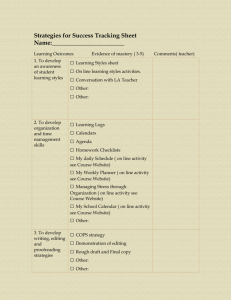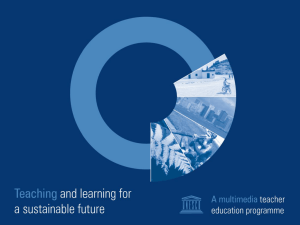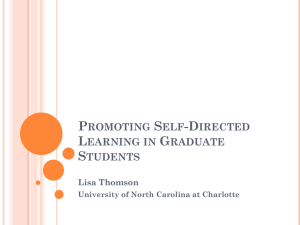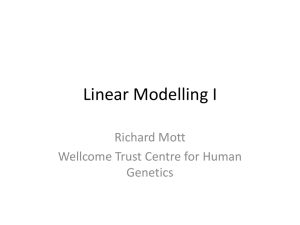David Stuart's presentation (PPT)
advertisement
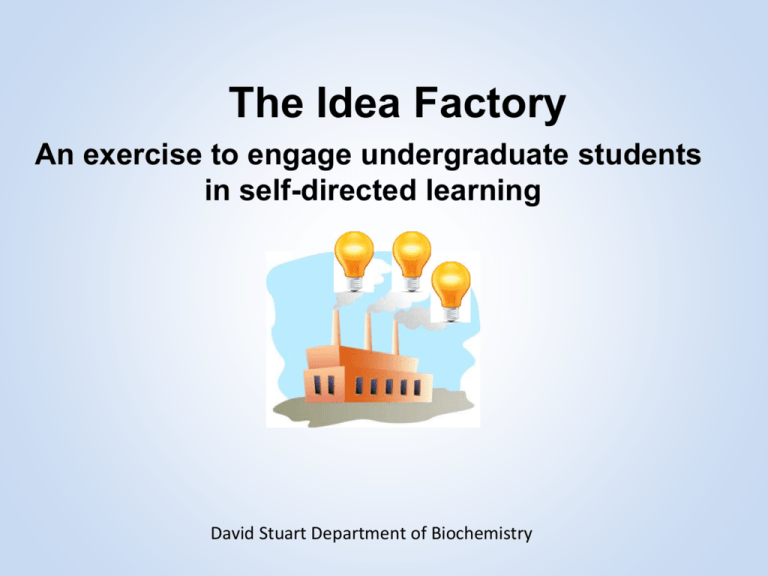
The Idea Factory An exercise to engage undergraduate students in self-directed learning David Stuart Department of Biochemistry My Teaching Biochem 200 Bioch 450/450 Biochem 630 Introductory Biochemistry (200-500 students) Virology Molecular Biology (3 students) Bioch 425/525 Proteomics (20 – 60 students) Lectures assignments Read and interpret papers Discussion and presentation of literature Biochem 425/525 Proteomics About 20 students, mix of graduate and undergraduate Large scale study of proteins in cell, their structures, functions and how they interact with one another. Evolving Bioch 425 with elements of “flipping Teaching with more than didactic lectures Create a focus on self-directed learning “In its broadest meaning, ’self-directed learning’ describes a process by which individuals take the initiative, with or without the assistance, in diagnosing their learning needs, formulating learning goals, identify resources for learning, choosing and implement appropriate learning strategies, and evaluating learning outcomes.” (Knowles, 1975, p. 18) Why employ self-directed learning - A valuable way to teach students how to learn. - Transferrable learning skills. - A sense of control over learning results in greater acquisition of materials. - Allows students to explore the available resources and discover others. Self-directed learning provides choices “Everybody is a genius. But if you judge a fish by its ability to climb a tree, it will live its whole life believing that it is stupid.” - Albert Einstein and adaptability Self-directed learning promotes creativity and innovation Educating students in how to learn creates the ability for life long learning. This also takes advantage of natural curiosity. Allows students to exercise their creativity. The idea factory project Structured self-directed learning SSDL Identify a problem that can be solved or investigated with proteomics. Present the problem and your solutions to a panel of judges and the class. Convince the panel that your problem is worthy of investigation and that they should fund you to investigate it. Preparation: students are given a lecture and assignment on how to read scientific papers. The Idea Factory Process Class divides into teams of 4 Team develops a solution Each team identifies a problem Team presents their problem and solution The “Dragons Den” Teams present to a panel of four evaluators (Departmental Chair, CEO Alberta Innovates) and the class. They must “sell” their idea to the evaluators as if seeking funding from the panel. 10 minutes presentation 5 minutes critique Questions from panel and class In the Dragons Den When the students arrive for their presentation each team is divided into presenters and critics Presenters Critics Presenters: Present the proposal. Critics: Outline limitations of the proposal. Evaluation of student performance Student performance criteria -The team displayed a clear understanding of the research problem and methods. - A convincing case was made for the importance of the problem. - The proposed methods were appropriate for the problem. - Creativity/innovation was displayed in the methods and analysis. - The project as presented was feasible. - Valuable results (knowledge, IP, data bases) would result from this investigation. - The team indicated how the work could implemented. - The presentation was well organized and coherent. - The team answered questions effectively. - The critics effectively identified limitations of the proposal. Measuring outcomes What do the students think? I learned more about the topic than I would have through a lecture. 96.3% strongly agree, n = 54 The exercise increased my understanding of proteomic technologies and applications. 98.1% strongly agree n = 54 I gained presentation skills. 85.2% strongly agree n = 54 I had the opportunity to exercise creativity. 83.3% strongly agree n = 54 The exercise provided understanding that did or could transfer to other research projects. 92.6% strongly agree n = 54 What the students did not like Uncertainty 11% of students would have liked to know before hand whether they would present or critique their proposals. How much should this influence the education process? Should we only do what the students like and feel that they benefit from?


